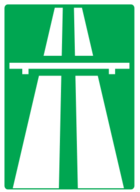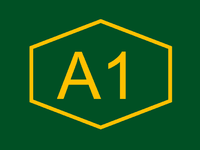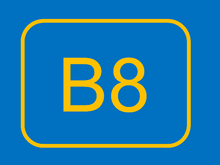Roads and motorways in Cyprus
Since the arrival of the first motor cars on the island in 1907,[1] Cyprus has developed a modern road network. According to 2002 statistics, the road network in the Republic of Cyprus-administered areas of Cyprus consists of about 7,206 km of paved and 4,387 km of unpaved roads. Although the first motorway in Cyprus, A1, was completed as recently as October 1985, the country already has the most motorway km per capita (38.6 km /100,000 inhabitants) among all European Union members.[2] There are no toll paying roads in Cyprus to date.

Maintenance
The Public Works Department of the Ministry of Communications and Works is responsible for the maintenance, improvement and construction of motorways, the majority of rural and interurban road network and the main urban roads. The Municipalities are responsible for the secondary and local urban roads; the District Administration Authorities are responsible for the paved and unpaved district (tertiary) roads and village roads. The Forestry Department is responsible for most unpaved roads in forest areas, this is in order to accommodate the administration and protection of forests.
The Turkish invasion of 1974 radically changed the program of road development and created new priorities in order to cover the augmented needs in the government controlled areas, where 80% of the Cyprus population and the greatest portion of development had concentrated.
Under these circumstances New Road Development Schemes were promoted, which were partially financed by foreign Financing Organizations. Under these development projects new 4 lane motorways were constructed and more are on their way as follows:
Cyprus motorways list

| Motorway logo | Connecting Cities | Status | Year completed | Special Features |
|---|---|---|---|---|
A1 highway logo | A1 Nicosia - Limassol | Completed | 1984 | 1st Motorway in Cyprus, 5,200m Emergency runway |
A2 highway logo | A2 Nicosia - Larnaca | Completed | 1991 | 1st Modern Motorway in Cyprus, 1st Motorway Interchange in Cyprus |
A3 highway logo | A3 Larnaca Airport - Ayia Napa | Completed | 2002 | First Beltway in Cyprus |
A4 highway logo | A4 Larnaca - Larnaca Airport | Completed | 1986 | Non Motorway given an A designation |
A5 highway logo | A5 Larnaca - Limassol | Completed | 1996 | 5,000m Emergency runway |
A6 highway logo | A6 Limassol - Paphos | Completed | 2006 | 950m tunnel, 110m tall bridge, one of the 300 largest in the world. |
A7 highway logo | A7 Paphos - Polis | Final Plans | - | 3 tunnels |
A8 highway logo | A8 Limassol - Saittas | Preliminary Designs | N/A | |
A9 highway logo | A9 Nicosia - Astromeritis | Partly under construction | 2014 | 1st Urban Motorway in Cyprus |
A22 highway logo | Nicosia 3rd Ring road | Final Plans | 2017 | 2 km long underground within Lakatamia |
The highway network is continuously developed. The first section of the A9 Nicosia - Astomeritis Motorway between Kokkinotrimithia and Akaki has been completed, whereas the rest is under study. Also the upgrading of the Limassol Junctions and the A1 Nicosia - Limassol Motorway to a 6 lane road between the Strovolos Junction and Alampra Interchange are completed.
The following are under design:



- Limassol Port connecting road. Construction began in 2012.
- A7 Paphos - Polis Motorway is promoted through the D.B.F.O. method (Design, Build, Finance, Operate).
Preliminary and feasibility studies are conducted for the:
- Nicosia 3rd Ring road
- A8 Limassol - Saittas Motorway
- Astromeritis - Evrychou Motorway
- Nicosia - Klirou Motorway
Road network categories and numbering
Roads and Motorways in Cyprus can be classified into 5 main categories:
- Motorways, 2 lanes per direction, free of any at-grade intersections. They are the most important road network on the island, and the letter "A" is used on their official numbering system. Motorways usually run parallel to the same-number "B class" intercity roads that they replaced and sometimes these roads are even transformed to Motorways (e.g. A3 Motorway and B3 road). While there is no formal announcement about the numbering of new motorways under construction and under planning, it's anticipated that they will have the same number as their current main road. So Limassol - Saittas Motorway will be coded A8 because A is the letter of Motorways and 8 because it will "replace" B8 road.
- Main Roads, Intercity roads, mostly one lane per direction, except sometimes in residential areas up to two lanes. B is the letter used in their official numbering system, with a number up to two digits long. Most of them have been replaced with their same-number Motorway (e.g. Traffic from Nicosia to Limassol now uses the A1 Motorway while in the past B1 road was the main connection between these cities)."B type" roads can be also main avenues within the city limits.
- Roads, secondary road network, mostly connecting rural areas. One lane per direction, always paved. They use the letter "E" in their formal numbering system and they are 3 digits long. First digit is the serial number of the main road that the secondary road begins from (or the secondary road, that begins at another secondary road which begins at a main road etc.) and the last two digits is the serial number of the road. Smaller digits where the main road begins, larger ones near main road's ending.
- Local roads, when coded during the 80's one lane and often dirt roads, today almost completely paved, and waiting for letter re - evaluation. They use "F" in the official coding system, and they are counted in the same way as "E"s are. There is no "E" with the same number as an "F".
- Unclassified roads. They can be "B" and "E" type. The case here is that these roads were constructed after the road network was numbered, so they will remain without a serial number and road signs will remain with gaps until the next road numbering evaluation.
Road safety
Cyprus currently holds a worse than average road safety record in the European Union[3][4]
Official figures:[5]
| 1991 | 1992 | 1993 | 1994 | 1995 | 1996 | 1997 | 1998 | 1999 | 2000 | 2001 | 2002 | 2003 | 2004 | 2005 | 2006 | 2007 | 2008 | 2009 | |
|---|---|---|---|---|---|---|---|---|---|---|---|---|---|---|---|---|---|---|---|
| Accidents | 3,172 | 3,052 | 3,021 | 2,080 | |||||||||||||||
| Injuries | 4,232 | 4,490 | 3,916 | 3,712 | 3,586 | 3,531 | 3,176 | 3,523 | 3,411 | ||||||||||
| Fatalities | 103 | 132 | 115 | 133 | 118 | 128 | 115 | 111 | 113 | 111 | 98 | 94 | 97 | 117 | 98 | 84[6] | 89 | 82[7] | |
| Fatalities/Million | 150 | 189 | 161 | 184 | 162 | 174 | 155 | 149 | 150 | 147 | 129 | 124 | 128 | 154 |
References
- Leonidou, Leo (10 Dec 2007). "100 years since Cyprus' first road trip". Cyprus Mail. Retrieved 2007-12-11.
- "Panorama of transport 2009". Eurostat. May 2009. Archived from the original (PDF) on 2012-03-01. Retrieved 2009-06-18.
- "EU road safety 2004 : Regional differences - Issue number 14/2007" (PDF). Eurostat. 6 February 2007. Archived from the original (PDF) on 6 March 2009. Retrieved 2009-02-02.
- "Improving road safety in Cyprus" (pdf). European Transport Safety Council. 15 December 2006. Retrieved 2009-02-02.
- "Road Safety Country Profile" (PDF). European Commission. October 2005. Archived from the original (PDF) on 2009-03-06. Retrieved 2009-02-02.
- Saoulli, Alexia (December 16, 2006). "Road safety improving, but more needs to be done". Cyprus Mail. Retrieved 2009-02-02.
- "More work needed to drop road toll". Cyprus Mail. January 28, 2009. Retrieved 2009-02-02.
Part of this article was copied from Cyprus's Press and Information office multimedia software "Aspects of Cyprus".